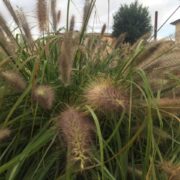GRASSES: ancient innovation
Grasses include a vast array of plants, approximately 10,000 species, which span from the most ancient grains to the wonderful ornamental variations used in parks and gardens.
These resistant plants adapt easily to the most varied environments, creating a charming atmosphere and, not to be undervalued, they are almost immune to phyto-pathological issues.
Thanks to their nearly “fluid”, soft appearance, they echo landscapes where the wind works together with the plants to create movement, new perspectives, a sense of space and sophistication as well. Imagine American pastureland, where the thin spikes of grain follow the wind, creating continuous movement along the field’s surface, or the cold cliffs of Scotland, where just a few types of grasses work together to create a charm and harmony which is practically unique throughout the entire world.
All this just to show all you can do with this varied group of plants, which are both resistant and affordable.
In the past, very few grasses were used in gardens, but today, thanks to research and effort, an increasing number of ornamental grasses can be used in landscaping, from the park to the garden, inserted into almost any setting.
A few landscaping ideas:
As mentioned above, given the variety of plants which you can find, the possibilities are truly endless, only limited by one’s creativity and the effects desired.
- As isolated specimens, to create a specific effect within a flowerbed or garden.
- As a border along streets, roads, flowerbeds or gardens, thanks to their variety in terms of form and colour.
- For very arid, dry soil where they manage to survive just fine, bringing life to areas which would otherwise be bare and difficult to manage.
- On balconies, terraces, courtyards and patios, used in planters to create effects which once were unimaginable, adding colour, even in winter, to urban landscapes which tend to be sad and grey.
Forms and colours:
Grasses come in many different forms, starting from stalks as straight as a spear and leaves as soft as pillows or as fluid as water flows. They can resemble peacock feathers or rigid structures, small bushes or long edging, conferring effects of every type of and genre. They’re quite tall, some a few metres high, or low and compact. Small the soft or majestic and robust!
In terms of colour, they range from bright green to bronze, from red to violet. They can be almost white, ivory, yellow or grey with special decorations on the tips or on the leaves, adding depth and a wider range of uses, enriching backgrounds in flowerbeds, perspectives in gardens or creating milieus in parks, and so much more.
Bloom times:
Given the incredible variety of species, there are grasses which show off their utmost beauty at all times of the year.
In particular, a few varieties are at their peak during the cold season, displaying special tonalities which bring a touch of cheer to gardens, flowerbeds and terraces when other plants are hibernating or at least when their growth is rather limited.



